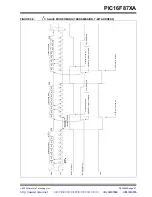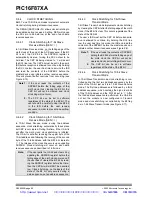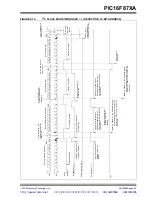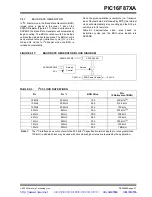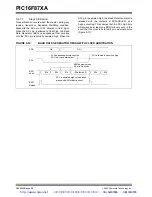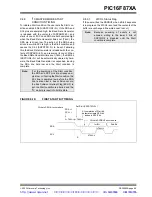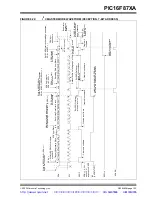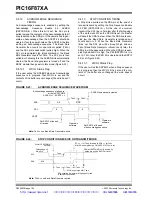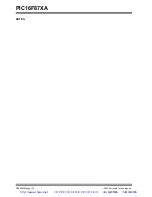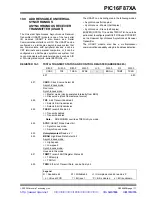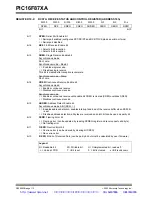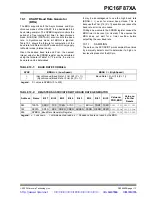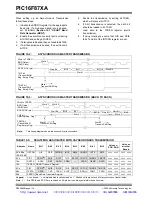
2003 Microchip Technology Inc.
DS39582B-page 101
PIC16F87XA
9.4.10
I
2
C MASTER MODE
TRANSMISSION
Transmission of a data byte, a 7-bit address or the
other half of a 10-bit address is accomplished by simply
writing a value to the SSPBUF register. This action will
set the Buffer Full flag bit, BF, and allow the Baud Rate
Generator to begin counting and start the next trans-
mission. Each bit of address/data will be shifted out
onto the SDA pin after the falling edge of SCL is
asserted (see data hold time specification, parameter
#106). SCL is held low for one Baud Rate Generator
rollover count (T
BRG
). Data should be valid before SCL
is released high (see data setup time specification,
parameter
#107). When the SCL pin is released high, it
is held that way for T
BRG
. The data on the SDA pin
must remain stable for that duration and some hold
time after the next falling edge of SCL. After the eighth
bit is shifted out (the falling edge of the eighth clock),
the BF flag is cleared and the master releases SDA.
This allows the slave device being addressed to
respond with an ACK bit during the ninth bit time, if an
address match occurred or if data was received prop-
erly. The status of ACK is written into the ACKDT bit on
the falling edge of the ninth clock. If the master receives
an Acknowledge, the Acknowledge Status bit,
ACKSTAT, is cleared. If not, the bit is set. After the ninth
clock, the SSPIF bit is set and the master clock (Baud
Rate Generator) is suspended until the next data byte
is loaded into the SSPBUF, leaving SCL low and SDA
unchanged (Figure 9-21).
After the write to the SSPBUF, each bit of address will
be shifted out on the falling edge of SCL, until all seven
address bits and the R/W bit are completed. On the fall-
ing edge of the eighth clock, the master will deassert
the SDA pin, allowing the slave to respond with an
Acknowledge. On the falling edge of the ninth clock, the
master will sample the SDA pin to see if the address
was recognized by a slave. The status of the ACK bit is
loaded into the ACKSTAT status bit (SSPCON2<6>).
Following the falling edge of the ninth clock transmis-
sion of the address, the SSPIF is set, the BF flag is
cleared and the Baud Rate Generator is turned off until
another write to the SSPBUF takes place, holding SCL
low and allowing SDA to float.
9.4.10.1
BF Status Flag
In Transmit mode, the BF bit (SSPSTAT<0>) is set
when the CPU writes to SSPBUF and is cleared when
all eight bits are shifted out.
9.4.10.2
WCOL Status Flag
If the user writes the SSPBUF when a transmit is
already in progress (i.e., SSPSR is still shifting out a
data byte), the WCOL is set and the contents of the
buffer are unchanged (the write doesn’t occur).
WCOL must be cleared in software.
9.4.10.3
ACKSTAT Status Flag
In Transmit mode, the ACKSTAT bit (SSPCON2<6>) is
cleared when the slave has sent an Acknowledge
(ACK =
0
) and is set when the slave does Not Acknowl-
edge (ACK =
1
). A slave sends an Acknowledge when
it has recognized its address (including a general call)
or when the slave has properly received its data.
9.4.11
I
2
C MASTER MODE RECEPTION
Master mode reception is enabled by programming the
Receive Enable bit, RCEN (SSPCON2<3>).
The Baud Rate Generator begins counting and on each
rollover, the state of the SCL pin changes (high to low/
low to high) and data is shifted into the SSPSR. After the
falling edge of the eighth clock, the receive enable flag
is automatically cleared, the contents of the SSPSR are
loaded into the SSPBUF, the BF flag bit is set, the
SSPIF flag bit is set and the Baud Rate Generator is
suspended from counting, holding SCL low. The MSSP
is now in Idle state, awaiting the next command. When
the buffer is read by the CPU, the BF flag bit is automat-
ically cleared. The user can then send an Acknowledge
bit at the end of reception by setting the Acknowledge
Sequence Enable bit, ACKEN (SSPCON2<4>).
9.4.11.1
BF Status Flag
In receive operation, the BF bit is set when an address
or data byte is loaded into SSPBUF from SSPSR. It is
cleared when the SSPBUF register is read.
9.4.11.2
SSPOV Status Flag
In receive operation, the SSPOV bit is set when 8 bits
are received into the SSPSR and the BF flag bit is
already set from a previous reception.
9.4.11.3
WCOL Status Flag
If the user writes the SSPBUF when a receive is
already in progress (i.e., SSPSR is still shifting in a data
byte), the WCOL bit is set and the contents of the buffer
are unchanged (the write doesn’t occur).
Note:
The MSSP module must be in an Idle state
before the RCEN bit is set or the RCEN bit
will be disregarded.
http://www.xinpian.net
提供单片机解密、IC解密、芯片解密业务
010-62245566 13810019655

